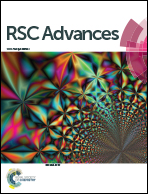Determination of folic acid by capillary zone electrophoresis with indirect chemiluminescence detection†
Abstract
A capillary electrophoresis method with on-line inhibited chemiluminescence (CL) detection was first used to determine folic acid (FA). This method was established based on the quenching effect of FA on the CL reaction of luminol with a Ag(III) complex in alkaline medium. The separation was conducted with a 20.0 mM sodium borate buffer containing 1.0 mmol L−1 luminol. Under optimized conditions, FA was baseline separated and detected in less than 10 min. The limit of detection of FA was 1.3 mg L−1, with a linear range of 5.0–150.0 mg L−1 (r = 0.9953). The RSD value was 2.8% for intra-day precision and 5.4% inter-day precision. The recoveries of the standard addition of tablets and human urine ranged from 90.3% to 107.5% and from 82.0 to 105.7%, respectively. The proposed method was successfully applied to determine FA contents in commercial pharmaceutical tablets and human urine samples. Results suggested that this method was simple and robust.



 Please wait while we load your content...
Please wait while we load your content...